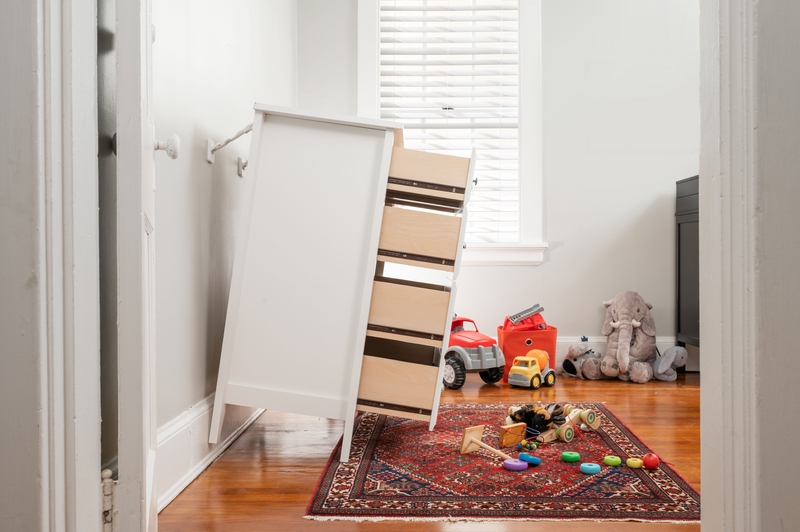- AppliancesElectriciansHVACLandscapingLocksmithPest ControlPlumbingRenovationRoofingT V RepairAll Home Improvement
- Car AccidentClass ActionCorporate LawCriminal DefenseDivorce LawEmployment LawFamily LawFinancial LawLegal AidMedical Injury LawyersMedical MalpracticeReal Estate LawWater Fire RestorationAll Legal
- InvestmentRetirementAll Finance
- Animal InsuranceAutoGeneral InsuranceHealth PolicyHome RentersAll Insurance
- DentalHealth SpecialistsAll Medical
- Animal CareVeterinaryAll Pets
- Auto GlassTowingAll Automotive
Secure Your Furniture to Prevent Tip-Overs: A Step-by-Step Guide

Home safety is paramount, and one critical aspect often overlooked is the prevention of furniture and TV tip-overs.
Read More Home Improvement Articles
Accidents involving unsecured furniture and televisions can have serious consequences, especially for young children. Anchoring these items to the wall is a simple yet crucial step that can prevent accidents and provide peace of mind.
Assess Tip-Over Risk
Before you start anchoring furniture and TVs, assess your home for potential tip-over hazards. Identify tall or top-heavy furniture pieces, such as dressers, bookcases and entertainment centers, as well as large, flat-screen televisions that could pose a tipping risk. Prioritize anchoring items that are in areas frequently accessed by children or in high-traffic zones.
How to Anchor Furniture and TVs: 12 Simple Steps
Things You’ll Need
- Anchoring kit
- Screws
- Screw anchors (if applicable)
- Wall brackets
- Screwdriver or drill
- Level
- Pencil
media/?
Step 1: Choose the Right Anchoring Kit
Anchoring kits come in various sizes and types. Select a kit that suits the weight and size of the furniture or TV you intend to anchor. Read the packaging to ensure it's appropriate for your specific needs.
Step 2: Locate Wall Studs
Wall studs provide the most secure anchor points. Use a stud finder to locate the studs behind the wall. Mark their positions with a pencil.
Step 3: Measure and Mark
Measure the desired height and position where you want to anchor the furniture or TV. Use a level to ensure accurate positioning. Mark the spot with a pencil.
Step 4: Attach Wall Brackets
For furniture anchoring, attach the wall brackets to the back of the furniture piece, using the holes provided. For TV anchoring, attach the brackets to the back of the TV, following the manufacturer's instructions.
Step 5: Secure the Straps
Secure the anchoring straps to the furniture or TV brackets following packaging instructions. Make sure the straps are taut and properly fastened.
Step 6: Drill Pilot Holes
For furniture anchoring, drill pilot holes into the marked wall studs. Use a drill bit that's slightly smaller than the screws provided in the anchoring kit. For TV anchoring, follow the manufacturer's instructions to determine the appropriate drill bit size.
Step 7: Install Wall Anchors
If your wall brackets don't align with wall studs, you'll need to use wall anchors. Drill holes slightly smaller than the wall anchors and then insert the anchors into the holes. For extra-heavy pieces, you might want to use toggle bolts instead of anchors. These bolts open up behind your drywall and provide a super-secure anchor point.
Step 8: Secure Wall Brackets
Attach the wall brackets to the wall studs using screws. For wall anchors, insert the screws through the brackets and into the anchors. Make sure the brackets are securely fastened to the wall.
Step 9: Attach Straps
Secure the furniture or TV by attaching the straps from the item to the bracket on the wall. Make sure the straps don't have too much slack in them.
Step 10: Test Stability
After securing the furniture or TV, give it a gentle tug to ensure it's stable and properly anchored. If everything is secure, it shouldn't budge or wobble.
Step 11: Conceal Cables
For TV anchoring, use cable clips or organizers to secure and conceal the cables, preventing them from becoming a tripping hazard.
Step 12: Regular Maintenance
Periodically check the anchors to ensure they are still secure. Over time, screws can loosen, and straps may need adjustment. As your children grow, make sure to reevaluate the height and positioning of furniture and TVs to maintain a safe environment.
More Related Articles:
- How Much Does a Home Inspection Cost?
- 4 Tips for Hiring a General Contractor for Your Next Remodeling Project
- Should You Hire a Contractor or a Handyman?
- 5 Things to Look For When You're Hiring an Electrician
- What to Look for When Hiring an Exterminator
Additional Tip-Over Safety Tips
- Follow the manufacturer's instructions. Always follow the manufacturer's instructions when anchoring furniture and TVs. They provide specific guidelines for your items.
- Secure top-heavy Items. Items with a higher center of gravity are more likely to tip over. Secure these items even if they seem stable.
- Secure drawers and doors. Use drawer and door latches to prevent children from climbing on furniture and causing it to tip. Also, try not to store heavier items in the top drawers of potential tippable furniture to keep it from getting too top-heavy.
- Educate children. Teach your children about the importance of not climbing or pulling on furniture and TVs. Keep remote controls, toys and tempting items off high surfaces.
- Avoid placing items out of reach. Discourage placing heavy items on top of furniture, as this can increase the risk of tipping. Children may also try to climb up to reach items placed on top of furniture, which can cause heavy pieces to tip over.
- Seek professional help. If you're unsure about the anchoring process or if you have extremely heavy or complex items, consider seeking the help of a professional carpenter.
Anchoring furniture and TVs to walls is a proactive step that can prevent accidents and ensure the safety of your family. By following these steps and using the right supplies, you create a secure living environment that protects your loved ones from potential tip-over hazards. Remember: Home safety is an ongoing effort, and regular maintenance and awareness are key to maintaining a safe and secure home for everyone.
Elocal Editorial Content is for educational and entertainment purposes only. Editorial Content should not be used as a substitute for advice from a licensed professional in your state reviewing your issue. Systems, equipment, issues and circumstances vary. Follow the manufacturer's safety precautions. The opinions, beliefs and viewpoints expressed by the eLocal Editorial Team and other third-party content providers do not necessarily reflect the opinions, beliefs and viewpoints of eLocal or its affiliate companies. Use of the Blog is subject to the
Website Terms and Conditions.The eLocal Editorial Team operates independently of eLocal USA's marketing and sales decisions.



